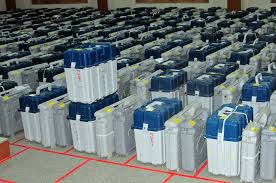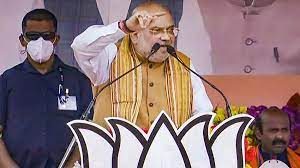The idea of EVMs was first conceived in 1977 and in August 1980, the Election Commission of India demonstrated its first prototype before the representatives of political parties
The credibility of Electronic Voting Machines (EVM) is questioned with every election in India. Whether it is assembly polls or the Lok Sabha, EVMs — introduced in 1982 to replace the ballot system — have to face ‘agni pariksha’ despite getting a clean chit in at least 25 court cases and being termed “credible, reliable and totally tamperproof”.
Since 2001, various courts have either rejected a plea or given clean chit to EVMs at least 25 times. Of these cases, nine were in the Supreme Court in the last 10 years and 16 in various high courts. However, there is a buzz in political circles again, with the Opposition questing EVMs.
The highest number of cases were filed in Delhi, Madras and Madhya Pradesh high courts – three each. There were two cases each in Bombay and Gujarat high courts and one each in Rajasthan, Uttaranchal and Karnataka.
In December, Congress MP Jairam Ramesh wrote to Chief Election Commissioner Rajiv Kumar, requesting for a meeting of INDIA bloc leaders to raise concerns on VVPAT. Last week, the poll body wrote back to him, saying his letter has “no new assertions or reasonable and legitimate doubts” which require further clarifications than what are already in the public domain.
Read More: UPSC Success Story: Meet IAS Vijay Wardhan, Who Overcame 35 Failures To Achieve UPSC Success
News18 takes a look at how EVMs have stood the test of time:
HISTORY OF EVMS
The idea of EVMs was first conceived in 1977 and in August 1980, the Election Commission of India (ECI) demonstrated its first prototype before the representatives of political parties.
After reaching a wide consensus on its introduction, in May 1982, EVMs were used on a pilot basis to conduct elections. For the next one-and-a-half decades, several reforms and policy changes were introduced and committees were formed to analyse the new technology.
In 1998, a general consensus was reached on the use of EVMs. The new system was used in 16 assemblies across Madhya Pradesh, Rajasthan, and Delhi.
The next year, EVMs were used in 46 Lok Sabha constituencies. The slow yet gradual increase in the use of EVMs continued in various assembly elections. In 2001, Tamil Nadu, Kerala, Puducherry, and West Bengal elections were conducted using EVMs alone and since then it became a norm for all assembly polls.
In 2004, the new technologically advanced voting system completely replaced the erstwhile use of ballot papers with EVMs used in all 543 Lok Sabha constituencies.
Almost a decade later, in 2013, Voter Verifiable Paper Audit Trail (VVPAT) were added to improve the transparency and verifiability in the polling process.
Read More: PM Modi To Kick-Start Lok Sabha Election Campaign From Champaran, Bihar On Jan 13: Report
EVMS IN COURT
The oldest case against EVMs dates back to 2001 in the Madras High Court, seeking to prohibit EC from using EVMs in the Tamil Nadu Assembly election that year.
In its order, the court said the advantages of EVMs outweigh the conventional ballot boxes. It highlighted the need for printing a huge number of ballot papers and invalid votes in the old system.
In the EVMs, invalid votes do not arise, and every vote will be accounted for. The court also said that no rigging is possible, and results can be ascertained in a shorter time.
In 2004, a case was filed in Karnataka High Court related to the efficacy and integrity of the EVM. It said EVMs are vulnerable to tampering and elections conducted with them do not ensure free and fair polling and counting.
The court put aside the doubts, saying the invention of EVM is undoubtedly a great achievement in electronic and computer technology and a national pride.
Cases related to EVMs also emerged in 2009 (Rajasthan), 2010 (Madras), 2012 (Gujarat), 2014 (Madras and Madhya Pradesh), 2017 (Bombay and Uttarkashi), 2018 (Bombay and two cases in Madhya Pradesh), 2019 (Delhi and Gujarat), 2020 (Delhi) and 2021 (Delhi).
Between 2013 and 2023, orders in nine cases were delivered by the Supreme Court in favour of the EVMs. Three cases were disposed of in 2013, one in 2018 and two each in 2019 and 2022, and one in 2023.
In almost all the cases, the EVM came out strong. In two of the cases, one in the Supreme Court (Rs 50,000) and one in Delhi High Court (Rs 10,000), the court not just dismissed the cases but imposed fine on the petitioners.
In the 2023 case, the Supreme Court refused to entertain a plea that sought directions to the ECI to conduct an independent audit of the source code of EVMs. The court said that the petitioner has placed no actionable material on the record of the court to indicate that the EC is actually in breach of its constitutional mandate of holding elections.
These were just the cases where the technology and the machine were questioned for credibility. Some cases are still pending in courts even as the country gears up for the 2024 Lok Sabha elections.



































